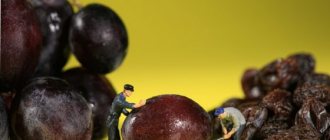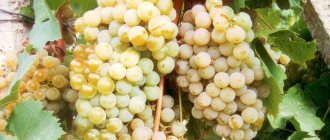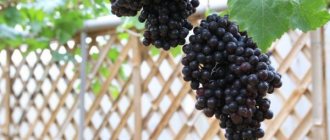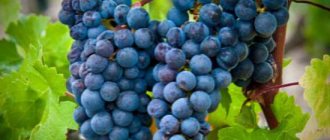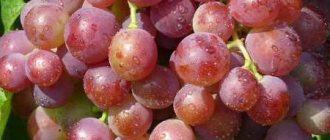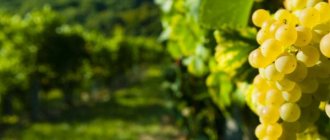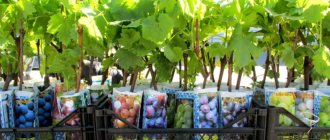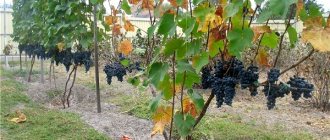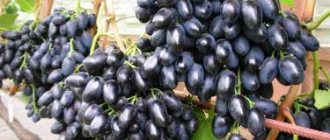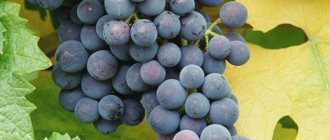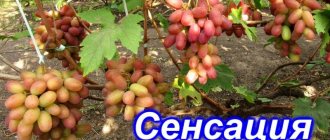Pros and cons of the variety
“Livadia Black” is an ideal raw material for making wine. This grape is quite unpretentious and has good frost resistance. The advantages of the variety also include:
- High yield.
- Resistance to a number of diseases.
- Good keeping quality.
- The optimal combination of sugar and acid in berries.
Disadvantages include low resistance to bacterial diseases and the need for timely harvesting to avoid loss of its taste.
Description of the grape variety “Livadia Black”
The variety meets all the basic requirements for wine grape varieties:
- resistant to pests, diseases and frosts;
- contains the maximum amount of minerals and vitamins;
- the juice content in the berries reaches 80-90%;
- sugar content not lower than 20%;
- the structure of the brush corresponds to the optimal ratio of the weight of the comb to the weight of the berries. This eliminates the negative impact of the green part of the ridge on the taste of the wine;
- load on a bush – up to 30 eyes.
Productivity usually ranges from 110-150 c/ha , which is a good indicator. Resistant to frost down to -25 degrees . On an eight-point tasting scale, the rating is 8 points.
Super Extra, Arched and Beauty of the North are also frost-resistant.
Among the shortcomings, it should be noted that the appearance of the bunches is not very luxurious, which is typical for most wine varieties. This nuance is fully compensated by its excellent taste and winemaking characteristics.
Description
“Livadia Black” is one of the most famous varieties of technical grapes, bred by breeders of the All-Union Scientific Research Institute of Winemaking and Viticulture “Magarach”. The Armenian table grape “Megru Vagaas” and the variety “Magarach No. 124-66-26” were chosen as parent plants.
All work was supervised by the outstanding scientist, specialist in the field of physiology and genetics of grapes P. Ya. Golodriga, who is also the creator of the Gurzuf pink, delight and amethyst varieties. To continue the research of his works, the Limited Liability Company Scientific and Implementation was created, which the Federal State Budgetary Institution “State Variety Commission” calls the originator of this variety.
Harvest of “Livadian black”
History of the appearance of the variety
The author of the variety is Pavel Yakovlevich Golodriga. Initially, the variety was cultivated only in Crimea. Over several years of work to improve technical characteristics, the variety was zoned in the northern regions of the Russian Federation and Ukraine, where it is successfully cultivated to this day. The varieties “Magarach” No. 124-66-26 and “Megru Vagaas” were taken as parent plants.
Main characteristics
“Livadia Black” is a medium-early ripening variety – 130-140 days pass from the first buds to the harvest.
The plant is a medium-sized bush with a powerful vine and five-lobed green leaves with a dense leathery surface, serrated edges and a clearly defined central vein. It reaches its maximum size 3-4 years after planting, by which time about 75-80% of young shoots are capable of bearing fruit.
During the flowering period, light green bisexual flowers are formed on the bush, emitting a pleasant aroma and having the ability to self-pollinate even in the event of unfavorable weather conditions. At the end of flowering, fruits appear on the bush, collected in medium-sized and dense clusters of cylindrical or cylindrical-conical shape. The average weight of 1 bunch is 200-250 g.
Ripe berries are round or oval in shape and have a dense skin of a dark blue, almost black color, which appears gray due to the dense pruin coating. Each berry weighs 1.5-2 g, there are 2-3 small seeds inside. The fruits consist of 90% juice, and their sugar content, in case of favorable weather conditions, is 20-26% with an acid content of 7-9 g/l.
Important! With full ripening, sugar content and acidity decrease, so untimely harvesting can lead to the loss of not only the appearance of the grapes, but also the sugar and varietal taste.
The Livadia Black variety is a wine variety, so when creating it, the breeders did not set themselves the task of obtaining large berries and clusters; their goal was to create grapes with the required ratio of chemical components.
Thanks to their pleasant, harmonious, sweet taste and light muscat aroma, the fruits are ideal for making dessert wines with hints of nutmeg, prunes and notes of chocolate.
Diseases and pests
There are no plants that are completely immune to diseases. Various pests also cause a lot of trouble for winegrowers. Preventing and neutralizing these phenomena in time will be the key to a good harvest harvested without loss.
Pests
The most dangerous pests include grape aphids, wood borers, weevils, thrips, scale insects, cicadas, wasps, mites, leaf rollers, grape gnats, moths and flea beetles. Their main food is young shoots and leaves.
The development of insects occurs with the obligatory laying of eggs on the underside of the leaves. Spraying with contact insecticides should be carried out according to visual indications.
You need to fight the borer and wood borer after a thorough examination of the bushes and removal of all damaged shoots. Only after this can you start spraying. It is necessary to weed the vineyard and promptly remove dry leaves and fruits from the bushes.
Bacterial diseases
This group of diseases is caused by bacteria living in the soil and the plants themselves. The most common include:
- Bacterial cancer, the causative agent of which lives in all types of soil. The disease cannot be treated; the only way to combat it is to burn the diseased plant, from which it is forbidden to take planting material. For 3 years, a new plant cannot be planted at the site of the disease.
- Apoplexy also cannot be treated and is manifested by rapid withering of the bush. The only protection in these cases is preventive measures. Only proper care, precautions when purchasing planting material, and timely application of fertilizers will protect against incurable bacterial diseases.
- Mildew or powdery mildew affects the entire bush. The spores spread with the slightest breeze or drops of moisture and are able to survive the winter in the soil or on leaves. Removing dry plant waste and fungicidal spraying of the soil around the bushes are effective methods for preventing the disease.
- Grapes suffer from white rot. It can move from berries to shoots, which gradually begin to die. Infected brushes should be immediately destroyed and the bushes should be sprayed with Colfugo Super and Funzodol.
We should not forget about such common grape diseases as oidium, anthracnose, chlorosis, bacteriosis, and rubella. Timely preventive measures will ensure safety and a good harvest.
The love for grapes is well known; from the youngest gourmets to the elderly, you can hardly find someone who will say that they do not like sweet berries filled with sunshine.
The hard and painstaking work of growing and caring for grapes pays off with moments of pleasure from the taste of amazing fruits. The Livadia black variety will become a real decoration for your garden and table.
If you like black grapes, check out Moldova, Bull's Eye and Black Finger.
Comparison with analogues
In order to fully consider all the pros and cons of a variety, it is always useful to compare it with its competitors that are closest to it.
| Sign | Variety | |||
| Livadia black | Northern Saperavi | Isabel | Alpha | |
| Ripening period | 120-130 days | 140-145 days | 145-165 days | 110-145 days |
| Frost resistance | Up to -26 °C | Up to -23 °C | Up to -30 °C | Up to -35 °C |
| Yield per bush | up to 30 kg. | up to 100 kg. | 50 kg. | 150-180 c/ha |
| Bunches | 200-250 gr. | 100-150 g | 130-250 gr. | 150-250 g |
| Taste | Haronic | Simple and harmonious | Pronounced nutmeg, shades of strawberry, black currant | Sour |
| Color | Dark blue | Dark blue | Dark blue | Red-brown or purple |
| Disease resistance | Average | Average | High | Average |
| Shelf life | Few weeks | A few months | Few weeks | Up to 1 month |
| Sugar content | 20-26% | 20,7-25% | 18-20% | 15-16% |
| Acidity | 7-9 g/l | 6.2-11.3 g/l | 8-12 g/l | 10-11 g/l |
Rules for caring for the variety
Livadia grapes are demanding on soil nutrition. With a lack of minerals and organic matter, the quality and quantity of fruits is noticeably reduced. Basic care for this variety comes down to regular fertilizing, pruning and moisture control. Watering is rare, since the crop does not tolerate high humidity. It is best to combine moisturizing and feeding procedures.
In this case, the scheme for applying moisture and fertilizers is as follows:
- Throughout the entire growing season, from planting to August inclusive, watering is carried out once a month.
- Autumn moisture-recharging watering (if the weather is dry and sunny) + fertilizing with potassium salt and dolomite flour - for each bush 40 liters of water + 10 liters of water in which 10 g of potassium salt and 30 g of dolomite flour are dissolved. In cases where moisture-recharging irrigation is not required, fertilizers are incorporated into the soil in dry form in the same proportion.
- Spring water-charging watering (carried out under the condition that no watering was carried out in the fall or the winter turned out to be little snow) + fertilizing with manure - for each bush 20 liters of water + 10 liters of liquid mullein.
- 2 weeks before flowering, 10 liters of clean water and 10 liters of liquid mullein are added to each plant.
- Immediately after flowering - 10 liters of clean water for each plant + 10 liters of solution with 50 g of superphosphate.
- During the period of fruit filling - 20 liters of water for each bush + foliar feeding with parsley infusion (1 kg of parsley is used for 10 liters of boiling water).
After each moistening of the soil, after 14 hours it must be loosened to a depth of 15 cm near the bushes and 20 cm between the rows. The soil surface must be mulched with peat or compost. From the second year of plant life, formative pruning can be carried out on the site. On average, each young shoot should have 1–1.9 clusters, so they are shortened to 2–3 eyes.
The older the vine, the more clusters you can leave on it. By the 4th year of life, each mature shoot can support 3–4 bunches. In August, excess foliage is removed from the bushes, which prevents sunlight from reaching the fruits. In addition, excess stepsons that have not reached a length of 5 cm, which will thicken the crown, are removed. In the fall, broken branches are removed, sleeves are formed, and some of the shoots that do not bear fruit are removed.
Diseases and pests
"Livadia" grapes often become victims of pest attacks:
- woodworm;
- aphid;
- grape worm;
- weevil.
Insects can be eliminated using insecticides. The main thing is to choose a universal drug that has an active effect on all types of insect pests. One of the effective drugs is Fozalon. After treatment, insects and larvae die within 48 hours. The product has a long shelf life even at low temperatures. Solution consumption - 2 l/ha. Among plant diseases, bacterial infections are terrible.
Find out why grapes on the bush wither.
Bacterial diseases
The most common bacterial infections that can infect the Livadia grape variety:
- Bacterial cancer - the causative agent of the disease can develop on any type of soil; there is no effective treatment for it. Infected plants must be removed from the site and burned, and nothing can be planted in their place for 3 years.
- Apoplexy - there is no effective treatment for the disease. The only way out is timely prevention.
- White rot - the disease progresses quickly and spreads to all parts of the plant. When the first signs appear, the affected parts of the plants should be removed and burned. Then carry out urgent treatment with Fundazol according to the instructions.
The main measures to prevent the development of diseases and the spread of pests are correct agricultural techniques and the application of fungicides to the soil 3 times per season.
Did you know? Drinking wine in measured quantities reduces the risk of developing Alzheimer's disease by 70%.
The Livadia grape variety is actively used in wine production. The variety adapts well to any climate conditions and is relatively undemanding in care.
Features of cultivation
In the second year, after a sufficient number of fruit-bearing shoots have appeared, it is necessary to begin pruning the bush:
- Form 6-8 “sleeves” from the strongest and strongest shoots.
- Place them on trellises in different directions, leaving 5-6 vines on each.
- Trim each vine to 2-3 eyes.
The formation of the bush should be carried out in early spring, before the buds appear. If you prune grapes in the fall, before wintering, you need to leave more eyes - at least 4-5.
Reference! You can trim Livadia black in the summer if there is a need to remove dried leaves and shoots.
The end of June is the time for pinching, which consists in removing part of the shoots, which allows the bush to use nutrients for forming clusters rather than growth.
“Livadia black” is resistant to mildew, oidium and gray rot. At the same time, there are diseases that can damage the harvest or significantly reduce its volume if preventive protection of the vine is neglected. This variety is susceptible to:
- Apoplexy - the plant quickly fades; treatment consists of regular fertilization and proper care.
- Powdery mildew - the disease can be avoided by promptly removing dried leaves.
- White rot - a disease that affects fruits that need to be removed, and then the bush should be treated with “fundozol”.
In addition to diseases, “Livadian black” often suffers from attacks by pests: aphids, weevils, mosquitoes, wood borers, and scale insects. Insects settle on the inside of leaves and can only be gotten rid of by mechanically cleaning the plant or spraying the bush with special means. Removing dry leaves, weeding and treating with chemicals helps prevent pests from appearing.
Grapes can tolerate frosts down to -26 °C, but when grown in middle and northern latitudes, they must be covered for the winter - dig a sheet of plywood into the ground, lay the vines on it and cover them with sawdust, hay or soil.
Reference! The harvest is best stored in controlled atmosphere refrigerators. In such conditions, the fruits will last up to 120 days.
conclusions
- Black Livadia grapes, like Carménère, are a technical variety primarily intended for producing juice and wine.
- Ripe grapes have an optimal balance of sugar content and acidity, which makes it possible to obtain very tasty dessert wines.
- The berries are also consumed fresh. Although black Livadia looks unpretentious in appearance, it has excellent taste.
- The variety is demanding on soil composition. Grapes can only be planted in black soil or pre-enriched soil.
- The grapes tolerate frost well - down to -26 C, but in temperate and northern latitudes the plant should be covered for the winter.
Photo
Below are photos of the “Livadian black” variety.
Properties
The variety belongs to the wine variety, that is, during its selection the task was not to achieve the size of the berries and bunches, but to create the required ratio of chemical components.
Calorie content
In fact, the lowest calorie grapes provide 43 kcal per 100 g, so this kind of restriction is quite arbitrary.
Benefits and harms
Like any dark variety, Livadia black promotes hematopoiesis. Accordingly, berries are highly recommended for use with low or high blood pressure, cholecystitis, and atherosclerosis. In addition, grape juice helps thin the blood, which makes it very useful for those prone to blood clots.
Dark varieties are low in iron, so people suffering from anemia or children should choose green grapes.
- Although the calorie content of grapes is considered excessive, nutritionists advise using berries in mono-diets - 1.5 kg of grapes per day. The reason is the optimization of the gastrointestinal tract. Black grapes are able to change the acidity of the environment and prevent the formation of stones in the kidneys and bladder.
- The berries contain very high amounts of potassium, magnesium and calcium and help improve heart function.
- Livadia black has the ability to thin sputum, which significantly facilitates the course of pulmonary and bronchial diseases.
- The antioxidant effect of black grapes is well known. Berries are included both in the daily diet and in care products.
However, there are restrictions on the use of dark varieties.
- The acidity of Livadia black is quite high, so active use can damage tooth enamel.
- It is not recommended to use it to fight edema: due to the high sugar content and low amount of iron, the berries do little to help remove edema.
- Also, due to their acidity, grapes should be consumed with caution by people with high stomach acidity.
When strawberries ripen: timing and approximate ripening dates. Useful information on collecting and growing berries (85 photos and videos)
Acidity
The acidity of black Livadia is average – 7–8 g/l. This value is optimal for producing sweet dessert wines like Muscatel or Muscat. Find out about juice yield, growing and caring for Veles grapes here.
Reviews
Livadia black produces a good wine that tolerates barrel aging well. But I’m not sure about winter hardiness: in the winter of 2014-2015, my bushes were not covered and they froze thoroughly, although there were no severe frosts - a maximum of -18 °C, and a friend from Ukraine had an uncovered sleeve that overwintered perfectly at -25 °C , I don’t know how to explain it. Alexander
I live in Samara and have been growing Livadia black for about 10 years. A very promising variety - ripens in mid-September, is resistant to mildew and oidium, the risk of gray rot is minimal. In my opinion, it is not suitable for dessert wines if the autumn is damp - then there are few anthocyanins in it, but dry wine turns out good. Vasily, Samara
Forum statistics
207036 Messages in 1634 Topics from 5593 Users. Last user: Amaya Last message: “Let's talk about the weather in Vash...” ( Today at 07:52:22 ) Latest messages on the forum.
Now on the forum
30 Guests, 10 Users
Users in the last 15 minutes: 64nikolay64, Polina77, Mikhail Alekseevich, Yura, Svetla777, Tikhii, Marshal, Nikolay S., therapist, Liza [Blocked] [Section Moderator] [Forum Moderator]
Maximum online today: 77 . All-time maximum online: 2758 (28 July 2021, 17:22:51)
Users who visited the forum in the last 24 hours
Total: 294
(Visible: 293, Hidden: 1) 1963, 64nikolay64, Polina77, Mikhail Alekseevich, Yura, Svetla777, Quiet, Marshal, Nikolay S., therapist, Liza, Capricorn, lomakin1969, Alexander Vl., Elvira2017, Andrey76, Slavka, Mikhail77, ElenkaF, Tatyana B, Alex65, Cherkessk, Eugene, zsb, leonidych, vladimirM, yotmast, mers, Serg1707, SNovichek, hanter64, znakomij, Alexander K, Vardan, Sergey Fer, Anatoly Sivkov, Alexey V, Ilya 77, Andrey Gladilin, Tatyana A., Belgorodets, in Astrakhan, Oksana Kopp, sem_en, Vladimir 153, skier, Igor Viktorovich, slavalimon, Primorets, OlgaOs, SANYCH, 31rus, mystic69, DorontsovPeter, Andrey Tsvetkov, Buba, igor222, Elena Z, vlad51, Kenig, Nikolay Rex, Sergey 1965, Vladimir Buturlakin, DSW, psv1960, Dmitry 77, Vasily V., Vyacheslav03, Natalia Nikolaevna, Sergey Tashchiyan, Igor Sergeevich, alexsandr, kvg, Pioneer, Ekaterina Polyanina, nicson7, Elena Aleshchenko, Alexander-ask-34, Verona, Igor F., Taker, Henry, Yuri72, L.A.P., Yuri Gaivoronsky, Sergeevich, Sergei Chistokletov, Svetlana Streletskaya, Galinka, Alexey Deminov, Igor Naumov, Vyacheslav136, Gloomy, Katrin, AndSanych, Mikhno Alexander, Ded31 , Filippov Oleg, Vladimir ++, Lydia58, ALEXANDER BRYANSKY, Vladimir-kanevskaya, DIL, Amber7394, Marina Protasova, TITOVA LYUBOV, Linx, alexander66, Natalya M, Mikhail Fesenko, Amaya, Alexander71, Boris 1952, tsv, Maximilian, 25nata35, nadia, GALINA ANOKHINA, Igor_K, Alexander Kolesnikov, Ivan Levin, Pitko, weather forecaster, eSAa, cecet71, atseton, Alexander Smirnov, Vladimir Kostochkin, Vladimir Berdnikov, Gocha, pioneer-2, LeXa_KoT, Sergey 61, Sergey Yuryev, Erem, alexss, Evgeniy52, Skif, Vladimir Kovba, dayton, Yuri Semyonov, N.A. Sokolov, Pavlentiy, Sa-shura, Volgogradka, Dmitry Anatolyevich, Grandfather Igor, Andrey Lis, Bublichenko Alexander M, Marina Krymskaya, stenlly2010, irahelm, Vyacheslav Vladimirovich, Vladimir Shilov, Aprel, Dmitry Badaev, gheo55, y_fed, rambo, Yagodka, Valentina Ivanovna, Kryn, oleg9f, DED2, Svetlana Korotina, Oleg Ivanovich Zavezen, Eduard., santra, L2k2m7n, Alexander48, Viknik, Andrey 31, m2d, Valery Rastorguev, Soshnin Yura, Gardener - amateur, Galina, Vasily1111, gardener, marlin64, Salex, sergei, Sergey Ko, Ramiz, Victor_, kosmos, potap05, Yuri 36, VitalySD, Inna161, Vova Kapran, Vladimir Shcherbinin, Valerie, niy1, cfibr, Andrey68 , kulol3, thanatos, Serzh1978, Realist, Artur53, max2008-01, LOZA, AlexanderD, Grandfather Young, Natasha, Zayac, ketch, Rita, alx-74, Iv Iv, Alexander150, Igor K, Vasily Viktorovich, VeraNiK, kdm57, Veniaminovich , Boris Sokolyansky, 77volt, , vikbublik, neposny, Evgen, Victoria Aleksandrovna, Serezha 64, Wintel, Airbone, teri, Sergey Lomonosov, Khramov, serginio, Leonty Yarygin, Irina O., Ser, Nadezhda Grig, Lyubov S., netolya, Saisan, Alexey Agryzkov, Vadi, Zinaida, Vadim, Alexander Taganrog, Sergey Sukhonos, Snezhinets, evgen_26, nau_63, Masha_sadovod, Gennady163, krasnovlad1, Alexander Zinoviev, Vasily 53, Roman Fedorovich, TIS, Alexey Sergeevich, arnyusha, Zheka, Nurtas, kradievska , nick041, Valentina Medvedeva, Sergey43, Andrey S., Nikolay Lipunov, Mst, Vertuoz2, Vladimir VS, NatalyaMed, freesia, Kinna, Mikhail Michurinsk, alekcsan1, VALERY TAMB, Sasha57, MikhAf, Y_Azer, Andrey Beribesov, hunter1955, nut lover, Keys, Ivan Shmelev, Pestle, anton_slash, Nadymchanka, Sergey 31, Volgar, Pavel 64, Tatyana Volzh, Elektronik_t, Alexander 61, spotlight, Alexander Gai, Cheprak
Harvesting and application
Harvesting in the southern regions begins 130-140 days after flowering. In the northern regions, the ripening period is determined by the climate and the number of warm days; it may occur at the beginning of October. You should not delay the work, as if left for a long time, the berries lose their taste and begin to fall off.
Grapes Muscat Livadia
Spring is coming into its own.
Work will soon begin in the gardens and fields. A good owner thinks through the layout of the site in advance and selects new planting material. The grapevine has long been the best decoration for the garden and a delicious treat for children not only in warm climate regions, but also in the middle zone. The grapes have taken root even in Siberia. A new gardener has to make difficult choices. I don’t have enough experience in caring for and growing them; I want to get a good harvest. You need to choose a variety that is frost-resistant and so that it hurts less. It would be nice not only to have time to eat ripe berries, but also to try natural grape juice and prepare a flavorful liqueur for the winter. How to make a choice?
Experienced winegrowers would advise choosing from modern hybrids. Selective selection and crossing are aimed at improving the variety. Continue your choice among table varieties with early ripening. This is important for the central regions. We should have time to try the berries in the summer.
Start growing a vineyard with the hybrid Muscat Livadia. Wonderful Crimean grapes. It owes its appearance to the famous breeder P Ya Golodriga. Bred from the Crimean Pearl and SV 20-365 varieties. Its second name is Pavel Golodriga 5. The first name is more sonorous and beautiful. Most people know him. A village in Crimea with the same name for grapes, a winery and a variety of white wine. The variety is officially patented and included in the State Register of Ukraine.
Description
The variety is early ripening with a short growing season. In sunny weather and an average summer temperature of +25 degrees, you will taste the first berries in the second half of July. The bushes grow medium. Shoots with a good degree of ripening. To bear fruit on a plot, it is enough to have one bush, since the flowering of this hybrid is bisexual. In gratitude for your care, the vine will give you large, branched, slightly loose clusters with ripe berries.
Agricultural technology
Grapes are unpretentious to grow, but they are not grass and require care. This cultivated plant loves light soils: sandy, sandy loam and loamy soils. Choose the sunny side of the site. The best compass directions are south and southwest. To obtain a bountiful harvest, it is necessary to form the bush correctly. Trim shoots into 4–6 buds. The load on the shoots should be optimal. Do not exceed 35 eyes.
Livadia is a godsend for beginners. It is not afraid of the characteristic diseases of grapes. It firmly resists phylloxera, Mildew, oidium, and gray rot. You won’t scare it from frost either; it can withstand temperatures as low as -21°C. If winters are more severe in your region, be sure to cover the bushes so that the fruiting shoots do not freeze. Otherwise, in the spring it will be necessary to form the bush anew from young shoots. You won't be able to wait for an early harvest. Ripening will take an average of two weeks.
Productivity
The vine loves a hardworking winegrower. If you follow all the rules of agricultural technology, you can get from 120 to 150 centners of crop per hectare of planting area. The average weight of a bunch is 500 grams. The largest ones reach a mass of 800 grams. The volume and quality of the harvest directly depend on day and night temperatures. The ideal ripening regime for any grapes is: the daily norm is 25 – 30 degrees, the night norm is 10 – 15 degrees lower. Under such weather conditions, the maximum yield is achieved and a sufficient amount of sugar accumulates in the fruits. In rainy, cold summers, the taste of the berries changes sharply towards sour. Sugar content requires more heat and sun.
Taste and commercial qualities
After flowering, clusters of greenish berries begin to gradually form. By the end of the growing season, the berries become quite large, acquire an elongated shape and an amber color. It seems as if they have absorbed all the sun's rays during the summer.
It’s so pleasant on a summer evening to bite into the thin skin of a ripe berry with dense, fleshy pulp. Feel the subtle delicate taste of Muscat in the grape juice. Livadia berries contain from one to three barely noticeable seeds, which small children can easily handle.
The fruits of this type of Muscat are incredibly tasty. Sugar content 17 - 18%, acidity 5 - 6 grams per liter.
The assessment of the taste qualities of Muscat Levadia almost reaches its maximum value and firmly maintains its high rating - 9.5 points. Plant Muscat Levadia in your garden. You will never part with him again. This will be the first inhabitant of your vineyard, unpretentious and grateful
